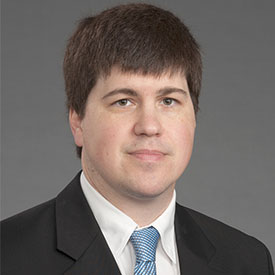 Alumnus Erik Summers, M.D., is section chief of hospital medicine at Wake Forest Baptist Health in Winston-Salem, NC. The UAB School of Medicine is in Erik Summers, M.D.’s cultural and literal DNA.
Alumnus Erik Summers, M.D., is section chief of hospital medicine at Wake Forest Baptist Health in Winston-Salem, NC. The UAB School of Medicine is in Erik Summers, M.D.’s cultural and literal DNA.
“My paternal great uncle was Dr. Garber Galbraith and two of my big mentors growing up were Dr. John Kirklin and Dr. Tinsley Harrison,” Summers, a 1997 graduate, says. “The reason I’m a hospitalist today is because of them. Interestingly, I helped establish hospital medicine
programs in two places where Dr. Kirklin’s and Dr. Harrison’s careers were shaped—the Mayo Clinic in Rochester, Minnesota, and Wake Forest University, where I’m associate chief medical officer.”
In addition to James Garber Galbraith, M.D.—founder of the UAB Department of Neurosurgery—Summers is related on his father’s side to L.V. Stabler, M.D., who, along with his sons, Ernest and Aubrey, and his brother (Summers’ great-grandfather) Andrew Lee Stabler, established the Stabler Infirmary in Greenville, Ala., around 1916. Today, the facility is known as the L.V. Stabler Memorial Hospital.
As fate would have it, Summers’ family helped recruit both Kirklin and Harrison to UAB. Even his grandmother contributed to the effort when she picked up Harrison from the airport for one of his interviews. “It was sort of a mom and pop effort back then,” Summers says. “For instance, Dr. Galbraith, in addition to founding the Department of Neurosurgery, was the first neurosurgeon in Alabama, and he would take calls for the entire state. Mobile would call and say, ‘Hey we’ve got a case,’ and my family would drive him to Mobile. On the way, he would sleep in the backseat of the car. It was a different time, different world back then.
 Dr. Summers with his wife Helena and daughters Celeste (left) and Analiese (right). “I was a child when Dr. Kirklin and Dr. Harrison came to UAB,” he says. “But they both came over to my family’s house for parties. As a 5- and 6-year-old child, I knew of these people—of course, I didn’t know how important they were nationally. But interacting with them was kind of the beginning of learning about UAB and that generation of doctors, and really if it wasn’t for them I would be a dramatically different physician. I feel that I think differently, even from physicians of my own generation, because of that interaction.”
Dr. Summers with his wife Helena and daughters Celeste (left) and Analiese (right). “I was a child when Dr. Kirklin and Dr. Harrison came to UAB,” he says. “But they both came over to my family’s house for parties. As a 5- and 6-year-old child, I knew of these people—of course, I didn’t know how important they were nationally. But interacting with them was kind of the beginning of learning about UAB and that generation of doctors, and really if it wasn’t for them I would be a dramatically different physician. I feel that I think differently, even from physicians of my own generation, because of that interaction.”
Kirklin taught Summers about process and process improvement, he says, while Harrison taught him about patient communication. “If you listen to your patients, they will tell you what is wrong with them,” he says. “Today, that approach might seem obvious but you would be surprised. Physicians can become fixated on tests and test results, but learning how to talk and listen to the patient is such a critical aspect of patient care. It’s almost becoming a dying art.
“Dr. Galbraith taught me professionalism. As far as I’m concerned, he was the best physician I was ever around. He was humble and brilliant. I recall once when he and I were watching a televised Alabama football game together and he got a phone call from a physician somewhere in the nation who wanted his advice on a patient. Dr. Galbraith gave him his diagnosis based on the description provided of the patient’s symptoms. The inquiring physician replied, ‘Well, the CT didn’t show that.’ And Dr. Galbraith said, ‘Use your clinical judgment. Take a history; do a physical.’ After he hung up, he turned to me and said, ‘See there? The test should confirm your clinical suspicion. You don’t order a test to make your diagnosis—you order a test to confirm your diagnosis.”
During his 16-year career, in addition to his work at the Mayo Clinic and Wake Forest, Summers helped establish a hospital medicine program at East Carolina University. Academic hospital medicine programs are responsible for all phases of care for hospitalized patients. And like departments of internal medicine or neurology, they are separate divisions or sections at their respective institutions.
Summers views hospitalists as the medical professionals who must lead the way in quality improvement and patient care improvement within hospital settings. “I wouldn’t have said that when I first went into hospital medicine, but after 16 years I believe hospitalists are the inpatient leaders for patient satisfaction, reduction of hospital acquired infections, reduction of inpatient medical complications, and decreased inpatient mortality and morbidity. In my opinion, hospitalists are the ones who are the future administrative leaders within the hospital. And nationally that’s where I see things are going.” Hospitalists have the advantage of being on the front lines, he says, where they can see the myriad nuances of patient care.
By Jo Lynn Curry